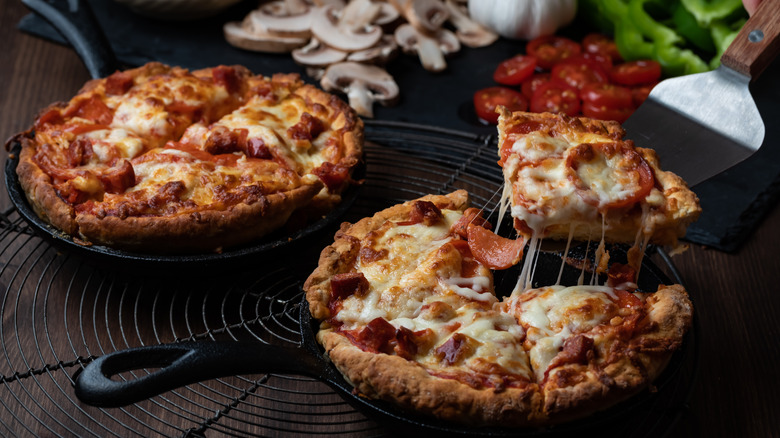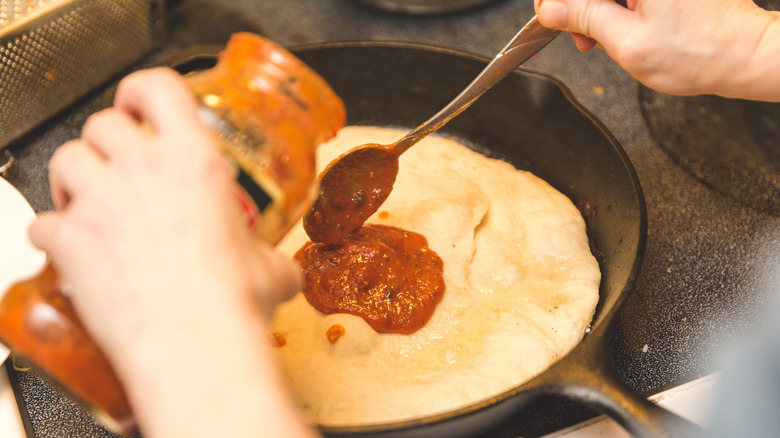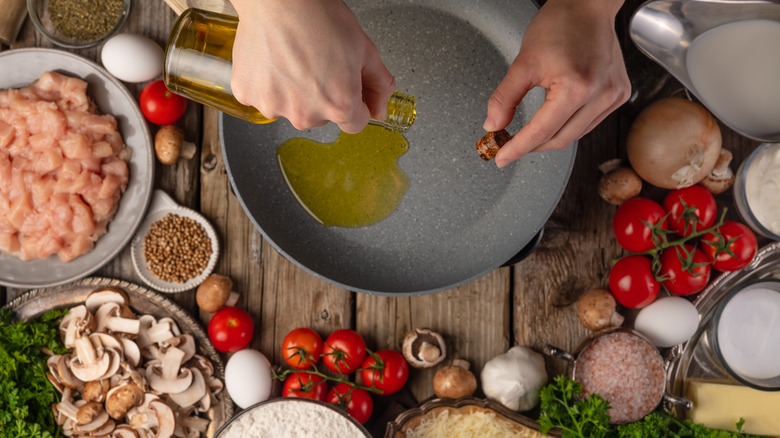Best Way To Prevent Pizza From Sticking To A Cast-Iron Skillet
If you've ever made cornbread in a cast-iron skillet (as most Southern-style cooks surely have), you already know that it's the perfect way to add a crispy crunchiness to the outer layer. Now, imagine that same principle applied to creating a mouthwatering pizza at home — no delivery driver required. The secret ingredients are a seasoned cast-iron skillet and a method for keeping the dough from sticking to the pan.
But first, there are a few choices to make. You can opt for preheating the pan and cooking it entirely in the oven on very high heat or sharing the process between the stovetop and oven, explains Epicurious. You'll also have to choose whether to use wet or dry ingredients to prevent sticking. Experts are pretty much split on both decisions. In the end, it's a kitchen dance — one step here, another there, and each chef ends up with their own version of perfection.
Dry ingredients keep pizza dough from sticking
It's generally accepted that preheating the pan in the oven begins the process of making pizza in a cast-iron skillet. Heat the oven to 500 F, and then add the pan and let it heat for roughly 10 minutes, per Epicurious. Remove and scatter a loose mixture of cornmeal and flour across the bottom of the hot pan to prevent sticking. Next, spread the dough across and up the sides of the pan to create what will become your outer crust. Spread a bit of oil on the exposed parts of the dough, and return the skillet to the oven to begin cooking. Keep an eye on the dough and remove it when you see bubbles start to form. Now it's time to add toppings and finish the cooking process in the oven again. Voila! You now have perfect pizza.
That's unless you want to sweeten things up a bit. Still using a dry mixture of cornmeal and flour to keep your pizza pie from sticking to the cast-iron surface, the Rachel Ray Show recommends you preheat the oven between 525 F and 550 F with the rack in the center, add a pinch of sugar to the dough for a sweeter crust, and then lower the oven heat to 400 F before popping it back in for the final step.
Using oil to prevent pizza dough sticking
Similar to Epicurious, Ree Drummond from Food Network also recommends heating the skillet in a 500 F oven, but the approach diverges from the previous recommendation by using oil instead of a dry mixture of flour and cornmeal. After preheating, coat the skillet with olive oil and then spread the pizza dough over it to prevent sticking. After adding toppings, brush any exposed edges of the dough, and then pop it right back into the oven. That way, you'll have crispy, crunchy goodness in every pizza bite, including the crust edges.
In a video from the Test Kitchen at Bon Appétit, Chef Claire Saffitz touts this variation of the approach. She stresses the importance of using a seasoned skillet and rubbing oil on both sides of the room-temperature dough before placing it in the hot, oiled skillet. The heated oil helps crisp the bottom of the crust while it cooks on the stovetop for a few minutes prior to adding ingredients and returning it to the oven. The browned crust, along with the accumulated layer of pre-seasoning in the pan, ensures an easy release of the pizza at the end of the entire process.
Whether you're using dry or wet ingredients to prevent sticking, cast-iron pan pizza will surely provide that perfect crispy crunchiness you're seeking.


